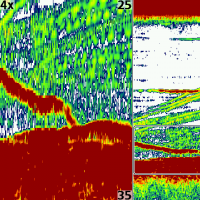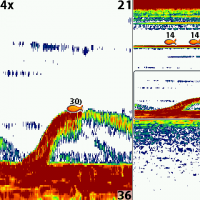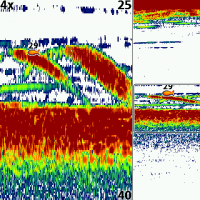Since the season is over, i’ll share what worked well for me this year….and it’s quite simple:
Fish where the big fish are, and then wait them out.
THat may sound cliche but…that’s what everyone says about every species. Fish where the fish ARE.
I very rarely will drop anchor and fish a spot because it “Looks” good, without first confirming that the area is holding big fish. Great thing about sturgeon in the St. Croix, is they’re the biggest fish in the system, and so are their returns on your sonar. I scan an area and drop anchor directly on top of a huge mark. If you spend enough time looking at your sonar, you’ll be able to tell when you are marking a BIG fish, versus a walleye, sheephead, smaller cats, etc… AFterall, if you’re looking for the biggest sturgeon, you must realize that they’re not in every area of every sturgeon hole…and when you do find them, they are significantly larger on your depth finder.
Now that you’ve found a few big fish on your depth finder, it’s time to fish them. Here’s where most people use a different tactic than myself; to each their own, but i’ll share mine.
I drop anchor vertical….Like straight down. I attach a bungee to my anchor rope to allow the boat to swell up and down without lifting my anchor. The more the wind blows, the less vertical i run my anchor. Even using two bungees to absorb the force of the wind and waves. Yes, my boat will sway, rock, but it’ll never budge the anchor. Anyone that knows me, knows i’m not wind shy and will fish sturgeon in 30-40mph wind, right in the wind blown areas….”Sturgeon don’t care”. This method that i’m about to explain allows me to fish the wind.
Now that my anchor is down, time to fish.
1oz to 2oz weights slipped onto my line. Swivel. 14-24″ of leader and an 8/0 circle. Bait that hook with your favorite bait. Now, loft your line away from the boat slightly, like 5′ and open the bail. The weight and bait will drop to the bottom (Don’t allow it to free fall, do so at a steady rate) and your bait will not helicopter around your weight causing problems. Once the weight has hit the bottom, put your rod in the rod holder. Allow weight to settle into position, it should be exactly below your rod tip, and exactly on the bottom, with zero slack in your line. Rock the boat slightly, and let out line so while the boat rocks, the weight isn’t lifting off the bottom. Rarely am i letting out more than 1-3′ of line. No, my rod tips aren’t bouncing 3′, but as the boat sways the weights are dragged around the bottom…Perfect!!
Rods should be orientated in the rod holders so they bounce the least. Depending on the direction the waves hit your boat, your should see a fairly constant rocking action happening, and placed your rods in an area where the tips bounce the least. With bells on your rods, bouncing of the boat should not cause bells to sound. A tap on the rod butt should cause them to sound though.
Ok, so now you’re fishing. Weight is either on the bottom, or dragging slightly above it. Bait, drifting 1-2′ behind the weight. Current and boat drift keeping the two separated. 2-6 rods spread out around the boat depending on where and how many people you have. BTW, the ONLY reason i do this vertical method of fishing rather than casting out lines is two fold: 1) My line is ALWAYS taut, and i’m ready to detect a sturgeon bite. 2) I don’t have to drop two anchors; which allow boat sway anyway, eventually causing slack lines, and then you just aren’t fishing effeciently.
#1 pet peeve while sturgeon fishing is slack in your line. You just aren’t fishing at this point.
Fishing vertical just flat out doesn’t allow slack to happen. The drifting, rocking, bouncing, etc…Isn’t detering any sturgeon bites either. Can have quite a bit of boat sway, as long as your weight is at or near the bottom…Tap tap tap
Set the 40 minute timer and start watching your sonar.
If a sturgeon taps your bait in this setup, you WILL see it in your rod tip, assuming you’ve done a good job of keeping your line relatively taut all the time. Bells should sound only with a sturgeon ‘hit.
When the hit happens, quickly reel until the rod either doubles over, or the bait is dropped. If the bait is dropped, immediately drop your weight back to the bottom. If rod doubles over…YOu’ve got a SHAKER! Pry that rod out of the rod holder and have some fun!
SHad caught everysingle fish over 48″ for me this year. Also caught fish on sucker, and worms.
So, that’s what i did 250 hours over the last 5 weekends…
I’ve noticed this year and kind of accepted the fact, that these Big fish, are not spread out, but can be quite concentrated at times. More than once has 40 yards been the difference from not only catching fish, but catching big fish. Once you are marking them big fish, make sure you’re not drifting past them and your anchor IS holding. The also will move/migrate. I set my timer for 40 minutes on my bird once baits are set, i only renew that timer after landing a fish, or if i’m waiting out some big arcs. If after 40 minutes the big arcs have left, and i have zero bites; i’ll pull anchor and scan the surrounding area and drop anchor again on another big arc. One, Two, Maybe Three more times of that and i’m off to the next major holding area to find the big arcs; returning at a different time to see if previously marked areas are ready to bite.
So, sometimes a small move, can be a great move.
Now, as for watching the sonar. I’ll attach some photos of my Bird. Few things i’ll point out;
1) A big fish on a sonar is identified by the THICKNESS of the return, not the length.
2) A big fish that has it’s noze to the ground and tail up, is about to slam your bait ![]()
3) These sturgeon sure do spend a heck of a lot of time suspended!!!! I’m tempted to start leaving 1 line suspended.
Pretty long read, but it’ll give you something to think about until next year’s hopefully much longer season!!



